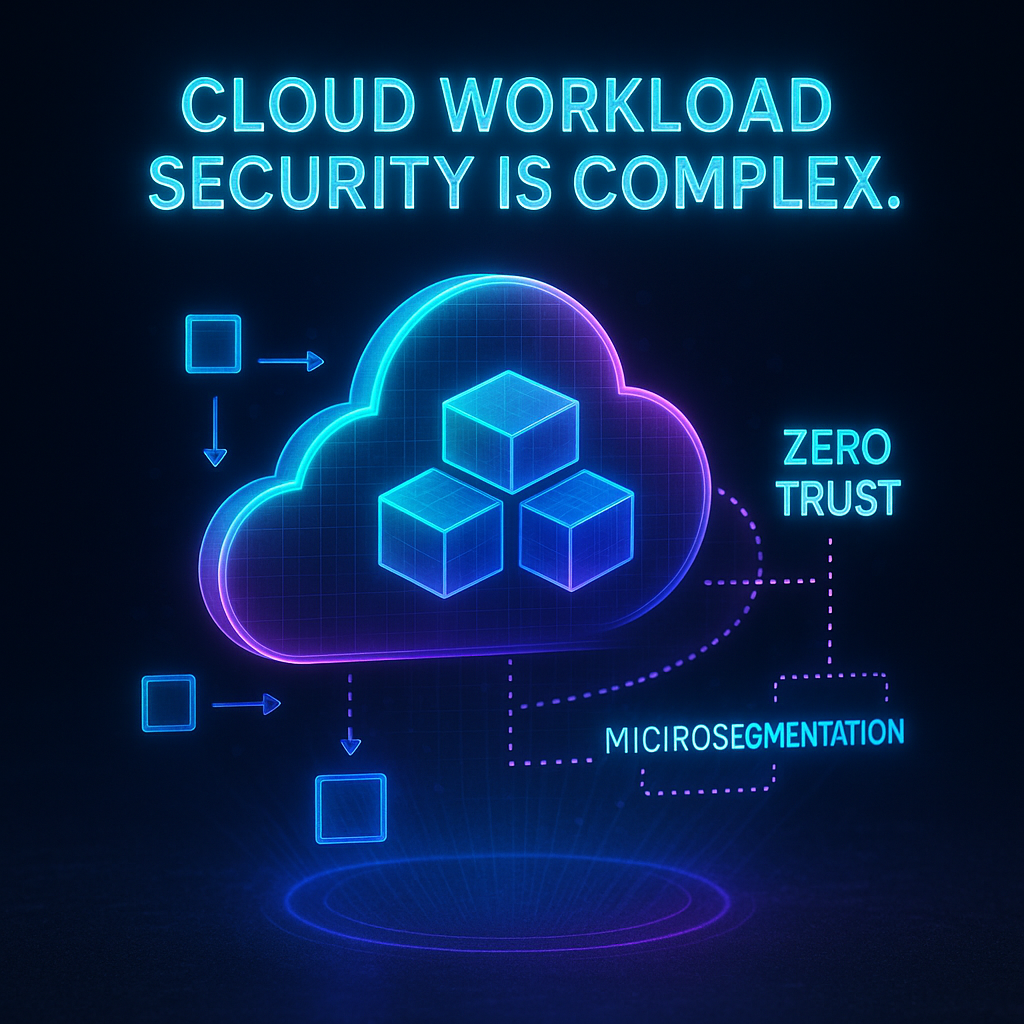What Is a Cloud Workload?
In today’s cloud-first world, the term cloud workload comes up everywhere. But what is a cloud workload, exactly? At its simplest, a workload is the unit of work that runs in the cloud: an application, service, or process – along with the compute, storage, and networking resources it consumes.
That could mean a virtual machine hosting a legacy app, a containerized microservice, a serverless function that spins up to process an event, or even a managed database offered by a cloud provider. In short: workloads are the building blocks of cloud computing.
Understanding workloads is step one. Step two is figuring out how to secure them. Because workloads are dynamic and distributed, traditional perimeter security doesn’t cut it. That’s why concepts like microsegmentation security and zero trust micro segmentation are now central to protecting cloud workloads.
Types of Cloud Workloads
Cloud workloads come in many forms. Each type introduces different security and management challenges:
- Virtual machines (VMs): Still widely used for lift-and-shift migrations. They’re predictable but come with legacy security challenges.
- Containers: Lightweight and portable, containers run microservices at scale. Kubernetes and Docker make them dynamic but harder to monitor.
- Serverless functions: Event-driven workloads that spin up and vanish in seconds. Great for agility, but ephemeral by nature.
- Managed services: Cloud-native databases, SaaS APIs, and messaging platforms. Critical for business, but harder to control because you don’t own the infrastructure.
- Hybrid & multi-cloud workloads: Organizations often run workloads across AWS, Azure, GCP, and on-prem. That creates policy drift and inconsistent controls.
Types of Cloud Workloads
Workload Type | Example | Risks | Security Considerations |
Virtual Machines | Legacy ERP on AWS EC2 | Patch delays, VM sprawl | Agent-based controls, OS hardening |
Containers | Kubernetes microservices | East-west traffic, misconfig | Network microsegmentation, RBAC |
Serverless Functions | AWS Lambda | Short-lived, hard to trace | Identity-based segmentation, strong IAM |
Managed Services | Cloud SQL, SaaS APIs | Limited visibility | Access control, encryption, monitoring |
Multi-cloud/Hybrid | Mix of AWS, Azure, GCP | Policy drift, inconsistent tooling | Unified microsegmentation tools, central IAM |
Why Cloud Workloads Matter
Cloud workloads are where the real business value lives: customer data, financial records, intellectual property, and the applications employees use every day. Downtime or compromise isn’t just an IT issue – it’s lost revenue, reputational damage, and potential regulatory fines.
Because workloads scale up and down constantly, and because many organizations share infrastructure (multi-tenancy), protecting workloads is harder than securing static on-prem systems. That’s why workload security has become one of the top priorities in cloud adoption strategies.
Security Challenges with Cloud Workloads
Securing workloads isn’t easy. The dynamic nature of cloud computing introduces unique problems:
- Ephemeral IPs: Workloads spin up and down with new IP addresses, making firewall rules brittle.
- East-west traffic: Most communication happens workload-to-workload inside the environment, unseen by perimeter defenses.
- Multi-cloud drift: Each cloud provider has its own security model, leading to inconsistent enforcement.
- Misconfigurations and insider threats: Still the leading causes of breaches.
Challenges of Cloud Workloads
Challenge | Why It Matters | Example Scenario |
Ephemeral IPs | Breaks static firewall policies | Container in Kubernetes gets a new IP every minute |
East-west traffic | Lateral movement often goes undetected | Ransomware spreading inside a VPC |
Multi-cloud drift | Different rules per CSP cause blind spots | Azure NSGs vs AWS SGs inconsistent |
Misconfigurations | Human error creates exposure | S3 bucket left public by mistake |
The Role of Microsegmentation in Protecting Workloads
Workloads are the new perimeter. Instead of securing a data center wall, modern teams must secure every workload individually. This is where microsegmentation security comes in.
With identity based segmentation, policies aren’t tied to network addresses. Instead, they follow attributes like env=prod, tier=app, or owner=finance-team. That makes micro segmentation networks far more resilient than VLANs or subnets.
Flow: Microsegmentation Lifecycle
- Discover traffic flows between workloads.
- Label workloads with attributes.
- Simulate policies in monitor-only mode.
- Enforce deny-by-default rules, creating small micro segments.
- Monitor & adapt as workloads change.
This lifecycle is what makes microsegmentation cybersecurity scalable across hybrid and multi-cloud environments.
Zero Trust and Cloud Workloads
Zero Trust is the philosophy: never trust, always verify. Microsegmentation is one of the tools that brings that philosophy to life.
With zero trust micro segmentation, workloads don’t assume trust just because they’re inside the same VPC or cluster. Every connection is authenticated, authorized, and logged.
Examples:
- A payroll app can only talk to the payroll database – not the HR system.
- A customer-facing API has no direct path to internal finance workloads.
This combination of zero trust and microsegmentation ensures workloads are only communicating when business policy says they should.
Cloud Workload Use Cases and Examples
Here are practical micro segmentation examples that apply directly to cloud workloads:
- Dev vs. Prod isolation: Keep test environments completely separate from production systems.
- Database protection: Only allow the right app tier to talk to the right database.
- Ransomware containment: Prevent malware from spreading laterally in hybrid clouds.
- Compliance-driven separation: PCI DSS or HIPAA workloads isolated into specific micro segments.
- Third-party access: Vendors get access only to the workloads they support – nothing else.
Table: Cloud Workload Use Cases
Use Case | Implementation | Business Value |
Dev vs Prod | Microsegmentation rules to isolate environments | Protects live data from test errors |
Database protection | Identity-based policies for DB access | Shields PII and financial records |
Ransomware containment | Network microsegmentation across hybrid | Minimizes downtime and losses |
Compliance isolation | Isolate PCI/HIPAA workloads | Cuts audit scope, avoids penalties |
Third-party control | Restricted access via micro segmentation security | Reduces supply chain risks |
Tools and Technologies for Cloud Workload Security
Different environments need different enforcement methods. Common options include:
- Cloud-native tools: AWS Security Groups, Azure NSGs, GCP Firewalls.
- Agent-based tools: Deploy agents on VMs/containers for granular control.
- Service mesh: Sidecars and mTLS in Kubernetes enforce zero trust micro segmentation.
- Host firewall / eBPF: Lightweight controls at the kernel level.
- Vendor solutions: Palo Alto microsegmentation and other commercial platforms.
Microsegmentation Approaches
Approach | Strengths | Limitations | Best Fit |
Agent-based | Deep workload context | Deployment overhead | Legacy + modern workloads |
Network-based (SDN) | Centralized control | Limited app awareness | Data centers |
Cloud-native | Easy to use, built-in | Per-cloud differences | Single-cloud |
Service mesh | Strong L7, identity-based | Operational complexity | Kubernetes microservices |
Host firewall/eBPF | Lightweight, efficient | Limited modeling features | Performance-sensitive apps |
Benefits of Securing Cloud Workloads with Microsegmentation
The adoption of microsegmentation security delivers clear outcomes:
- Reduced attack surface: Only necessary communication is allowed.
- Contained breaches: Attackers can’t move laterally beyond their entry point.
- Compliance made easier: Isolate regulated systems for PCI, HIPAA, ISO.
- Simplified policy management: Rules tied to identity, not IP trivia.
- ROI impact: Fewer breaches, lower audit costs, less operational overhead.
Benefits of Microsegmentation
Benefit | How It Works | Business Impact |
Smaller attack surface | Deny-by-default workload rules | Fewer entry points for attackers |
Contained breaches | Enforced micro segments | Faster incident response, lower costs |
Easier compliance | Isolate regulated workloads | Lower audit fees, avoid fines |
Simplified policies | Identity-driven segmentation | Less admin overhead, more consistency |
ROI impact | Reduced breach + audit costs | Strong business case for security |
Implementation Roadmap
A practical rollout looks like this:
- Day 0-15: Map workloads and flows.
- Day 16-45: Label workloads, simulate policies.
- Day 46-75: Enforce deny-by-default on key workloads.
- Day 76-90: Expand, automate, integrate into CI/CD.
This staged approach ensures micro segmentation networks evolve safely without breaking production.
Conclusion
Cloud workloads are the backbone of modern IT – but their dynamic, distributed nature makes them difficult to secure with traditional methods. By adopting microsegmentation cybersecurity and aligning it with Zero Trust, organizations can protect workloads at the most granular level, contain breaches, and simplify compliance.
The next step? Start by mapping your workloads, apply identity-based micro segmentation security, and move toward a zero trust and microsegmentation model. It’s not just about securing infrastructure – it’s about protecting the business itself.





